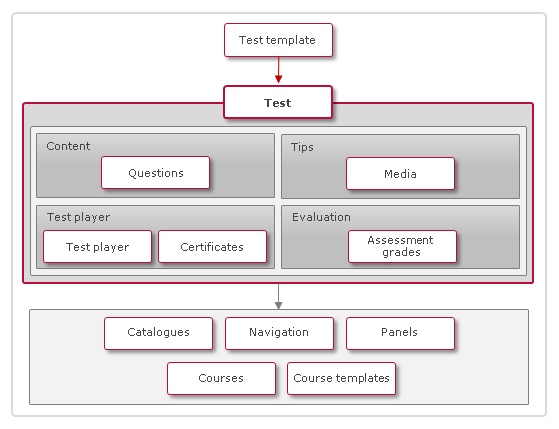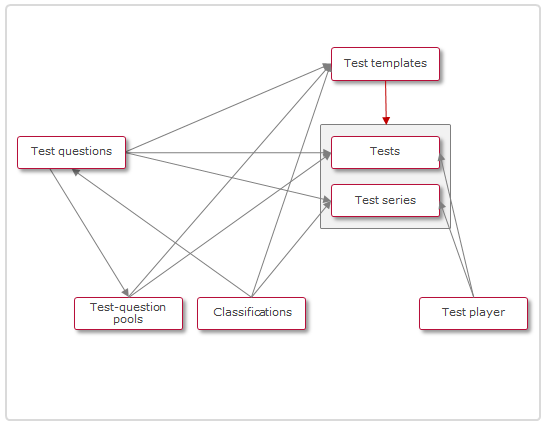Test Manager
Tests are used as syllabus elements in courses. They are used to check performance.
Tests that have a fixed set of questions and test series for which some of a defined number of questions are selected randomly for the learner are differentiated.
Tests consist of test questions that are evaluated automatically (e.g. multiple choice). If the test includes free-text questions, evaluation has to be conducted by a tutor for final results to become available. The final result is calculated according to points depending on the assigned test questions.
The options during test processing are determined via the test player (e.g. display of a question overview upon test launch).
Respective reports permit the evaluation of test results across multiple courses and users.
Tests are subject to versioning. Tests and test series can be created based on a test template.

Illustration: Use and Application of Tests

Illustration: Relationships between test objects
Functions of the Test Manager
New
Specialty: Tests can be created with or without templates. Therefore, the first step in the creation process involves the choice of whether a test series or test is to be created with or without a template.
Contents
Tests consist of test questions that are sorted and structured in folders.
Questions can be selected and added directly, or a set number can be selected at random. Alternatively, question bundles can be selected. This is accomplished by selecting a test-question pool that is managed as an object of its own in the system, or a classification. All questions in the pool or with the appropriate classification will be added.
The test mode states the importance of the test for checking performance, such as certification. The target learning-objective level determines the purpose of the test content, e.g. application or knowledge/understanding. Test mode and target learning-objective level can be edited again for each test-question folder. Both identifiers also exist for test questions and ultimately serve as selection propositions upon assigning questions. Questions can be defined as mandatory questions. In this case, the test can only be evaluated when the given question was answered. Upon creating a test with a test template, the template may already include questions. These questions can be updated to the current question version by clicking on the appropriate symbol.
Note on Test Series
In the case of test series, multiple questions are assigned, and it is determined per test folder how many of them are displayed to learners at random. For test series, questions can be defined as standard questions. As a result, the given questions will always be selected. In order to guarantee that a standardised evaluation can be carried out, the addition of free text questions to the test series is not permitted.
Evaluation
The evaluation of the test occurs on the basis of the sum of achieved points. Further, the achieved score is calculated (achieved points/possible points). The highest points achievable for the test must be greater than 0, so that a ratio and thus a meaningful test result can be calculated and reported.
Points are added up per folder. For each folder, a minimum percentage score can be determined. If it is not reached, the points of the folder will not be considered in the overall result.
By default, tests have the evaluation levels "Passed" and "Failed". Any number of other levels can be added. Levels are defined by a minimum score and a maximum score, in relation to the overall score. A test counts as a failure if the test result is in the lowest level.
Example:
Percent | Appraisal |
|---|---|
0% - 39% | Failed |
40% - 69% | Passed |
70% - 100% | Passed with honours |
In the sample case, the overall minimum test requirement would be 40%.
Proctoring
Tests can be set up for proctoring by choosing the procotoring service in the description tab. This integration requires a proctoring license and an agreement with the proctoring service provider. The procotoring service needs to be added in the external service provider manager in advance. When starting a test by clicking the test component the test/exam prechecks are started on the proctoring platform.
Test Player
The test-player setting determines the testing process for learners and enables or disables various additional information for a test:
Viewing options
Navigation
Options on feedback per question
Options on the display of results
Restriction of processing time
Test players are managed as objects themselves and can be selected upon creation or editing of a test. Manual, user-defined settings can also be adapted for each test, or existing test players can be selected and modified for the test. The resulting settings are also considered as user-defined.
If a test player is selected in the test but not modified with user-defined settings, its settings will not be changed when there are changes to the selected test-player object itself. The changes made to the test-player object can be made manually for the test. Default settings can be restored.
The "Lock with personal access code" option allows the possibility to define that the test will only be available to the learner when the correct personal access code is provided. The personal access code will be automatically generated per course per test per participant. It can be accessed via the course instruction syllabus tab, where a test can be selected and the overview accessed via progress per user. The personal access codes can also be sent via e-mail to the corresponding roles via the course component section.
New